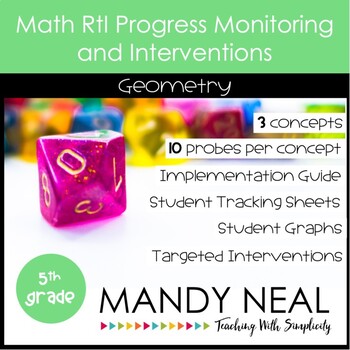5th Grade Math RtI Assessments & Intervention Binder Geometry Bundle
- Zip
Description
The 5th Grade Math Assessments and Intervention Binder has everything you need to implement Math RtI for Geometry in your classroom! The bundle contains two components. Components include: The 5th Grade Math RtI Assessments for Geometry and The 5th Grade Math RtI Intervention Binder for Geometry.
Below is a description of each resource.
5th Grade Math RtI Standards Based Progress Monitoring
Providing evidence of students learning is crucial. Progress monitoring will allow you to document student growth and make sure that the interventions that you administer are working. Everything you need to assess and track students is provided here.
Each of the Common Core Standards contain A LOT of little pieces. I broke these down into the pieces that my students needed to master in order to master the entire standard.
For example, within 5.NF.1, one particular student may not have difficulties adding fractions but may have difficulties subtracting mixed numbers. This student doesn’t need interventions or assessing with adding fraction, just subtracting mixed numbers. For this reason, 2 separate assessments for 5.NF.2 were written.
There are a total of 3 concepts covered within this resource. Each concept includes 10 assessments.
Progress monitoring forms and graphs are provided in both printable and editable form.
These assessments were created to align with the 5th grade Common Core Standards, but can also be used for below level 6th graders.
You can take a closer look here: 5th Grade Math RtI Standards Based Progress Monitoring
5th Grade Math RtI Intervention Binder
The standards-based intervention binder provides intervention activities for each Operations and Algebraic Thinking standard within the 5th grade curriculum. The Common Core State Standards were used to create the curriculum because even though not all states use CCSS, the majority of math curriculums match up with CCSS.
Each standard includes three levels of practice.
Level A: Maximum Support
Level B: Intermediate Support
Level C: Minimum Support
Level A contains maximum support and provides prompts and explicit directions. Within Level B, prompts and explicit directions are faded out. Level C was created to use once students are successful with Level B. This can be used as independent practice with or without partners.
Some standards have multiple strategies. For example, there are two strategies for students to multiply fractions. The strategies are using models and multiplying across. Five practice pages are provided for each strategy at Level A. Level B has five practice pages, which allow students to pick the strategy of their choice to solve.
There are a total of 3 concepts covered within this resource.
You can take a closer look here: 5th Grade Math Intervention Binder
If you have questions, please feel free to ask before purchasing! You can leave a question here or email me at mandy@teachingwithsimplicity.com!





